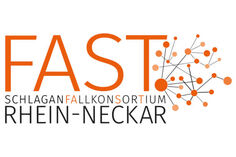Scientific study
FAST aims to achieve a measurable improvement in the care of stroke patients in the Rhine-Neckar region with a reduction in death and disability through more frequent and faster adequate treatment. The network is intended to demonstrate paradigmatically how the consequences of a widespread disease can be reduced through structural regional improvements in the quality of care.
The main objective of this study is an evaluation of the stroke network, which includes a feasibility and effectiveness analysis as well as a further development and transferability of the stroke concept to other regions. To this end, the following central question is to be answered: What improvements in terms of clinical outcome, quality of care and patient and staff satisfaction do the care structures implemented as part of FAST contribute to?
Calling those affected
Have you suffered a stroke in the past? Are you interested in science and would you like to contribute to improving stroke care? Then get in touch with us. We are looking for so-called Patient Researchers (m/f) to support us in incorporating the patient perspective into our research. For example, you will help us to better understand patient experiences and wishes and to incorporate aspects of stroke care that are relevant to those affected.
For more information, please contact the care coordinator of the FAST Stroke Consortium:
Your contact person
Register study
In order to optimise the therapy of acute ischaemic stroke against the background of current treatment recommendations, all patients with ischaemic stroke who are treated in hospitals of the Rhine-Neckar Stroke Consortium will be recorded as part of a prospective register. The aim is to carry out a feasibility and efficiency analysis of FAST with regard to an optimised care infrastructure for the implementation of time-critical acute stroke therapy, as well as to document any side effects and the clinical success of the treatment in a standardised manner. The changes in the care parameters are to be compared retrospectively (baseline) with a comparable period before the implementation of FAST. With this analysis, optimisation potentials can be evaluated and it can be examined whether the FAST network is suitable as a model for national and international stroke care .
The data summarised in this registry study are all taken from the course of treatment adapted to the individual situation in accordance with the guidelines . In particular, the registry study pursues the following objectives:
- Determination of care and treatment times starting with the onset of stroke symptoms through notification of the emergency medical services to the completion of acute stroke therapy, with special consideration of any recanalisation treatment that may have been carried out;
- Feasibility analysis of this care network against the background of the aforementioned objectives;
- Survey of the clinical situation by interviewing patients after approx. 3 months;
- Survey of complications and side effects during treatment;
- Hypothesis generation for the development of prospective studies as well as algorithms that optimise patient identification for different treatments.
- optimisation of patient identification for different treatment concepts for acute ischaemic stroke, taking into account the local care structure.
Database
A key aspect for the establishment of an effective stroke network is the establishment of a standardised and functional IT structure. As part of the network development, a FAST database will be implemented, which on the one hand ensures the quality assurance of the treatment and on the other hand enables the evaluation of the care network with regard to the therapy optimisation of acute ischaemic stroke.
The FAST database collects comprehensive data from the emergency services, the treating departments of the partner clinics, the (neuro)radiology departments of the partner centres and data on patient outcomes. The data collection is supplemented by data from the legally required quality assurance. The aim of all this is to ensure the best possible quality of treatment. The data collection is based on data from the regional quality assurance offices, questionnaires to the partner centres, interfaces for automatic data transfer including the possibility of transmitting imaging and online documentation in a central FAST portal.
The results of the data analyses are made available in the FAST network and published in joint publications - also in cooperation with existing (inter)national committees/groups.
FAST disease registry
One of the main components of creating an effective stroke network is the development of uniform and functional IT infrastructures. To this purpose, a FAST disease database is being implemented to enable quality assurance measures as well as allow for comprehensive evaluations of the network with regard to therapy optimisation for acute ischemic stroke.
